Paper Menu >>
Journal Menu >>
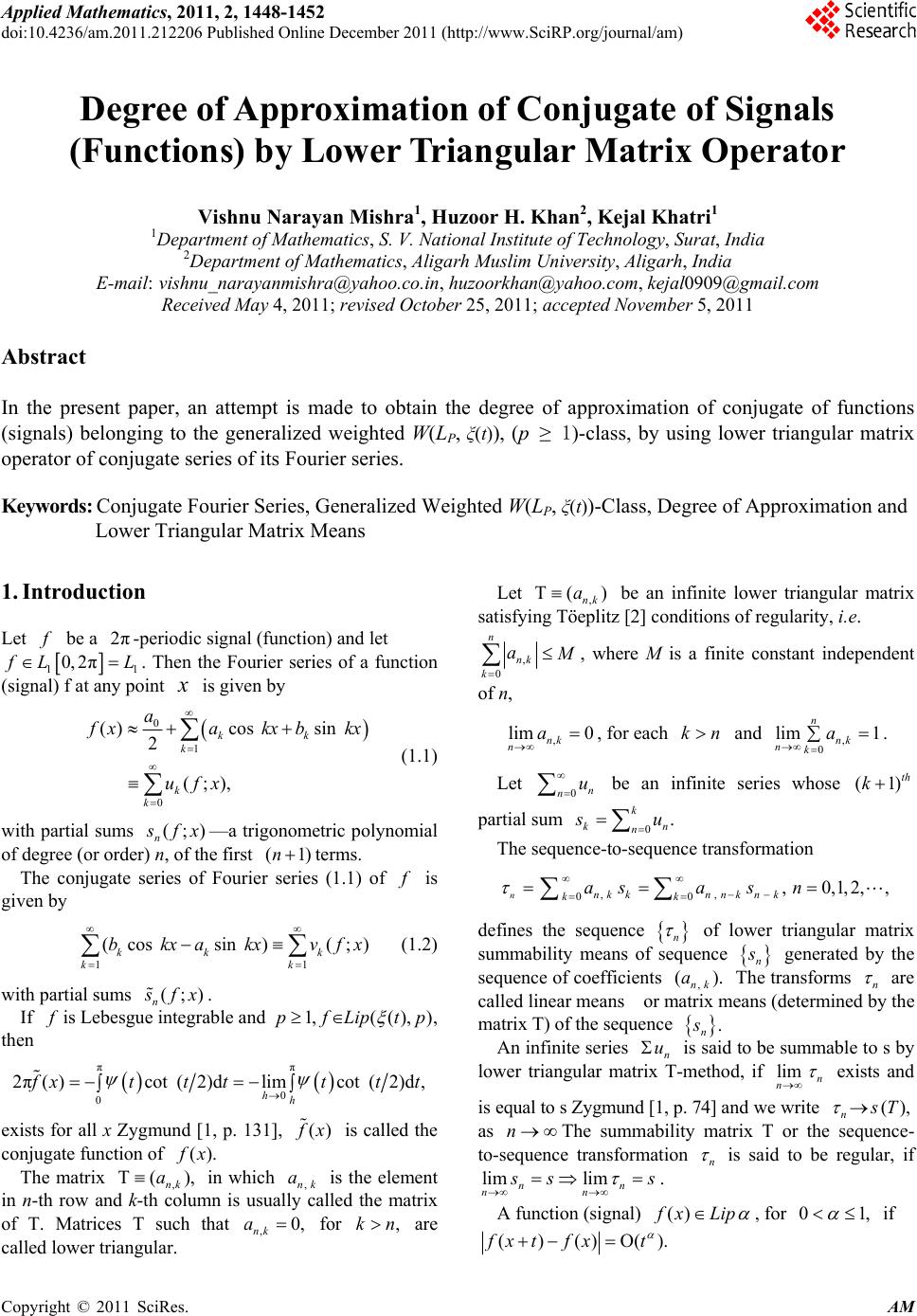 Applied Mathematics, 2011, 2, 1448-1452 doi:10.4236/am.2011.212206 Published Online December 2011 (http://www.SciRP.org/journal/am) Copyright © 2011 SciRes. AM Degree of Approximation of Conjugate of Signals (Functions) by Lower Triangular Matrix Operator Vishnu Narayan Mishra1, Huzoor H. Khan2, Kejal Khatri1 1Department of Mathematics, S. V. National Institute of Technology, Surat, India 2Department of Mathematics, Aligarh Muslim University, Aligarh, India E-mail: vishnu_narayanmishra@yahoo.co.in, huzoorkhan@yahoo.com, kejal0909@gmail.com Received May 4, 2011; revised October 25, 2011; accepted November 5, 2011 Abstract In the present paper, an attempt is made to obtain the degree of approximation of conjugate of functions (signals) belonging to the generalized weighted W(LP, ξ(t)), (p ≥ 1)-class, by using lower triangular matrix operator of conjugate series of its Fourier series. Keywords: Conjugate Fourier Series, Generalized Weighted W(LP, ξ(t))-Class, Degree of Approximation and Lower Triangular Matrix Means 1. Introduction Let f be a -periodic signal (function) and let 2π 11 0, 2π f LL. Then the Fourier series of a function (signal) f at any point x is given by 0 1 0 ()cos sin 2 (;), kk k k k a f xakxb ufx kx (1.1) with partial sums (;) n s fx—a trigonometric polynomial of degree (or order) n, of the first terms. (1)n The conjugate series of Fourier series (1.1) of f is given by 1 (cos sin )(;) kk k k bkxakx vf 1k x (1.2) with partial sums (;) n s fx . If f is Lebesgue integrable and 1,(( ),) p fLiptp , then ππ 0 0 2π()cot (2)dlimcot (2)d, hh f xttt tt t exists for all x Zygmund [1, p. 131], () f x is called the conjugate function of (). f x The matrix , in which ,nk a is the element in n-th row and k-th column is usually called the matrix of T. Matrices T such that for are called lower triangular. T( ), nk a ,nk a0,,kn Let , T( ) nk a be an infinite lower triangular matrix satisfying Töeplitz [2] conditions of regularity, i.e. , 0 n nk k a M , where M is a finite constant independent of n, , lim 0 nk na , for each and kn, 0 lim 1 n nk nk a . Let be an infinite series whose partial sum 0n nu (1) th k 0. k kn n s u The sequence-to-sequence transformation ,, 00 ,0,1,2, nnk knnk n k kk asas n , defines the sequence n of lower triangular matrix summability means of sequence n s generated by the sequence of coefficients ,nk The transforms n (a). are called linear means or matrix means (determined by the matrix T) of the sequence . n s An infinite series n u is said to be summable to s by lower triangular matrix T-method, if lim n n exists and is equal to s Zygmund [1, p. 74] and we write (), n s T as The summability matrix T or the sequence- to-sequence transformation n n is said to be regular, if li lim nn nn m s ss . A function (signal) () f xLip , for 01, if ()() (). f xt fxt 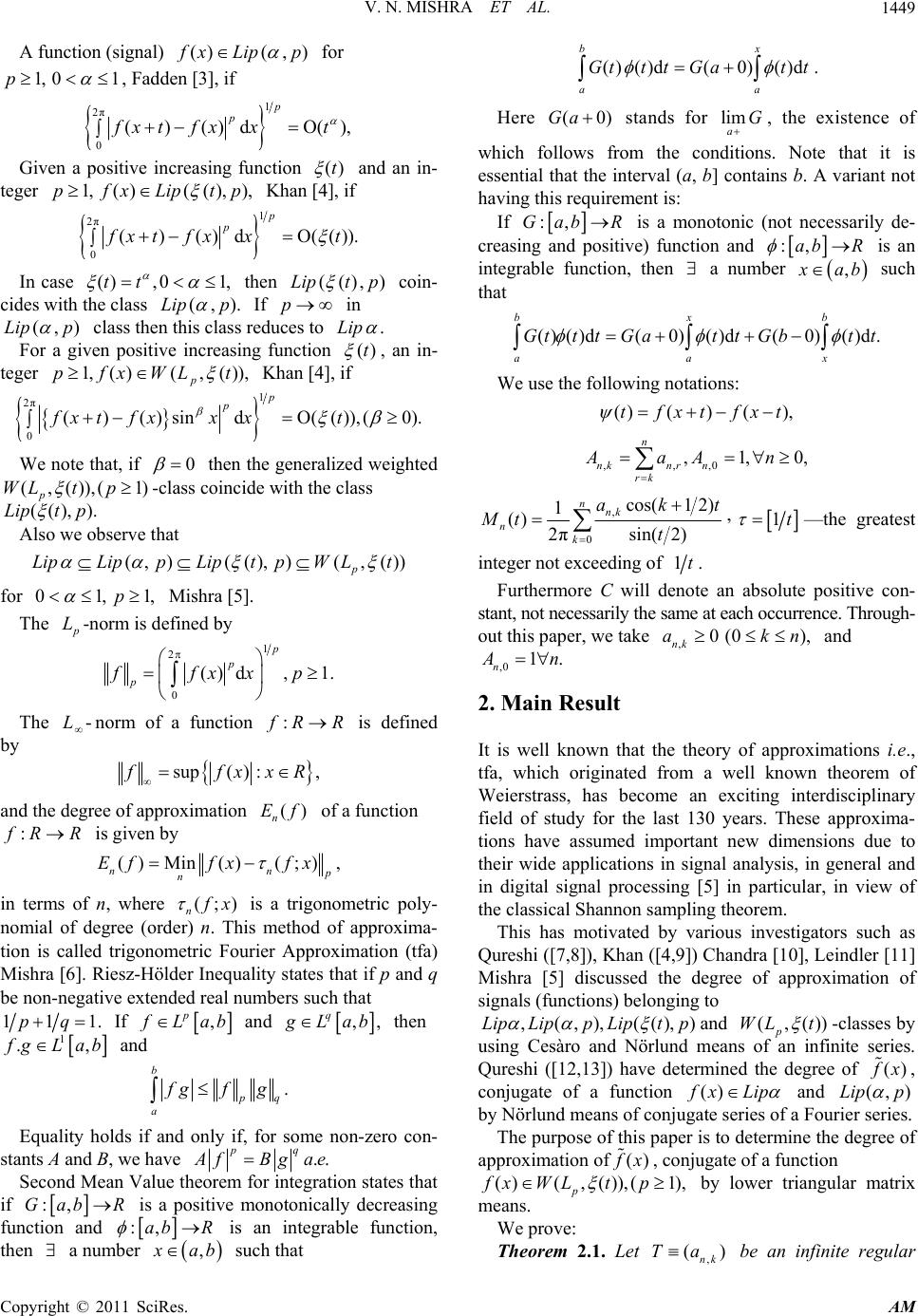 V. N. MISHRA ET AL.1449 A function (signal) ()( , ) f xLipp for 1, 01p , Fadden [3], if 1 2π 0 ()()d () p p, f xt fxxt Given a positive increasing function ()t and an in- teger 1,()(( ),),pfxLiptp Khan [4], if 1 2π 0 ()()d (() p p). f xt fxxt In case then () ,01,tt ((),)Lipt p coin- cides with the class (,)Lipp. If in p (,Lip p) class then this class reduces to .Lip For a given positive increasing function ()t , an in- teger 1,()(,( )), p pfxWLt Khan [4], if 1 2π 0 ()()sin d(()),(0 p p fx tfxxxt ). We note that, if 0 ) then the generalized weighted (,( )),(1 p WLtp ((), ).Lip t p -class coincide with the class Also we observe that (, )((), )(,()) p LipLippLiptpW Lt for 01,p1, Mishra [5]. The p L-norm is defined by 1 2 0 ()d, 1. p p p ffxxp The norm of a function is defined by -L:fR R sup() :, f fxxR and the degree of approximation of a function is given by () n Ef :fR R ()Min()(;) , nn p n Effx fx in terms of n, where (;) nfx is a trigonometric poly- nomial of degree (order) n. This method of approxima- tion is called trigonometric Fourier Approximation (tfa) Mishra [6]. Riesz-Hölder Inequality states that if p and q be non-negative extended real numbers such that 111pq. If , p fLab and ,, q g Lab then 1 .fgLab, and . b p q a fgf g Equality holds if and only if, for some non-zero con- stants A and B, we have .. pq A fBgae Second Mean Value theorem for integration states that if :,Gab R is a positive monotonically decreasing function and :,ab R , is an integrable function, then a number () ()d(0)()d bx aa Gttt Gatt . Here (0Ga) stands for , the existence of lim aG which follows from the conditions. Note that it is essential that the interval (a, b] contains b. A variant not having this requirement is: If :,Gab R is a monotonic (not necessarily de- creasing and positive) function and :,ab R is an integrable function, then a number , x ab such that () ()d(0)()d(0)()d. bx aa GtttGattGbtt b x We use the following notations: ()() (),tfxtfxt ,,,0 ,1, n nknr n rk AaA n 0, , 0 cos(12) 1, () 2πsin( 2) nnk n k ak Mt t t 1t —the greatest integer not exceeding of 1t. Furthermore C will denote an absolute positive con- stant, not necessarily the same at each occurrence. Through- out this paper, we take and ,0(0 ), nk akn ,0 1. n A n 2. Main Result It is well known that the theory of approximations i.e., tfa, which originated from a well known theorem of Weierstrass, has become an exciting interdisciplinary field of study for the last 130 years. These approxima- tions have assumed important new dimensions due to their wide applications in signal analysis, in general and in digital signal processing [5] in particular, in view of the classical Shannon sampling theorem. This has motivated by various investigators such as Qureshi ([7,8]), Khan ([4,9]) Chandra [10], Leindler [11] Mishra [5] discussed the degree of approximation of signals (functions) belonging to ,(,),((),LipLippLiptp) and (,()) p WL t -classes by using Cesàro and Nörlund means of an infinite series. Qureshi ([12,13]) have determined the degree of () f x , conjugate of a function ()fx Lip and (,)pLip by Nörlund means of conjugate series of a Fourier series. The purpose of this paper is to determine the degree of approximation of() f x ()),(tp , conjugate of a function ()(,1), p fx WL by lower triangular matrix means. We prove: x ab such that Theorem 2.1. Let , () nk Ta be an infinite regular Copyright © 2011 SciRes. AM 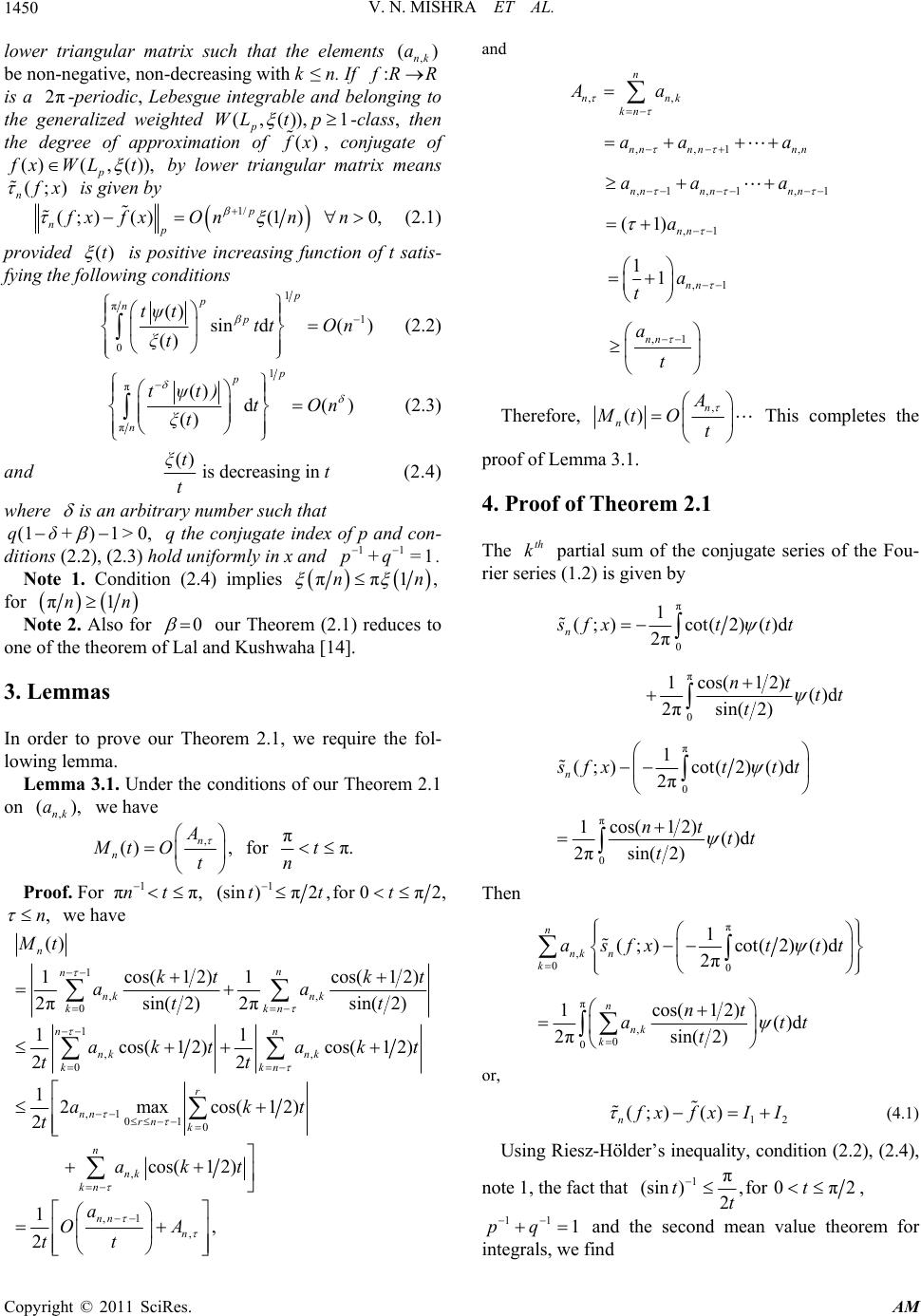 V. N. MISHRA ET AL. 1450 lo ix such twer triangular matrhat the elements , () nk a be non-negative, non-decreasing with k ≤ n. If :fR is a 2π-periodic, Lebesgue integrable and bel the gralized weighted (,()),1 p WLtp R ging toon ene -class, then the degree of approximation of () f x , conjugate of ()(, ()), p f xWL t by lower trian matrix means gular (;)fx n is given by 1/ ( n ided ;)()fx (1)n0, p p fx Onn (2.1) prov ()t ollow is positive increasinctiong fun of t satis- fying the fing conditions 1 π() p ntψt 1) 0 sin d ( () p ptt On ξt (2.2) 1 π π () d() () p p n tψt) tOn ξt (2.3) and ()is decreasing in ξtt t (2.4) where is an arbitrary number such that (1) 10,qδ>+ q the conjugate index ld uniformly in x and 11 1p+q= . Note 1. Condition (2.4) implies of p and con- ditions (2.2), (2.3) ho π π1,nn for π1nn Nrote 2. Also fo 0 our Theorem (2.1) f Lal mas o prove our Theorem 2.1, we requi nder the conditions of our reduces to re the fol- Theorem 2.1 on . Lem order t on e of the theorem oand Kushwaha [14]. 3 In lowing lemma. Lemma 3.1. U , (), nk a we have , () , n n A MtO t for ππ.t n Proof. For 1 ππ,nt 1 (sin )π2,for0 π2ttt, ,n we have 1 ,, 0 1 ,, 0 ,1 01 0 , , ()t 1cos(12)1cos(12) 2πsin( 2)2πsin( 2) 11 cos( 12)cos( 12) 22 12maxcos(1 2) 2 cos(12) 1 2 n n n nk nk kkn nn nk nk kkn r nn rn k n nk kn n M kt kt aa tt aktakt tt akt t akt a O t 1 ,, n n A t and ,, ,,1, ,1 ,1,1 ,1 ,1 ,1 (1) 11 n nnk kn nn nnnn nn nnnn nn nn nn Aa aa a aa a a a t a t Therefore, , () n n A MtO t This completes the proof of Lemma 3.1. 4. Proof of Theorem 2.1 The partial sum of the conjugate series the Fou- rier sees (1.2) is given by th k ri of π 0 π 0 π 0 π 0 1 (;)cot(2)()d 2π 1cos(12)()d 2πsin( 2) 1 (;)cot(2)()d 2π 1cos(1 2) 2πsin( 2) nt t () d n n sfxt tt nt tt t sfxt tt tt Then π , 00 π , 0 0 1 (;)cot(2)()d 2π 1cos(1 2)()d 2πsin( 2) n nk n k n nk k asfxt tt nt at t t or, 12 (;)() n f xfxII (4.1) Using Riesz-Hölder’s inequality, condition (2.2), (2.4), note 1, the fact that 1π (sin),for 0π2 2 tt t , 1 pq 1 1 integrals, we fi and the second mean value theorem for nd Copyright © 2011 SciRes. AM 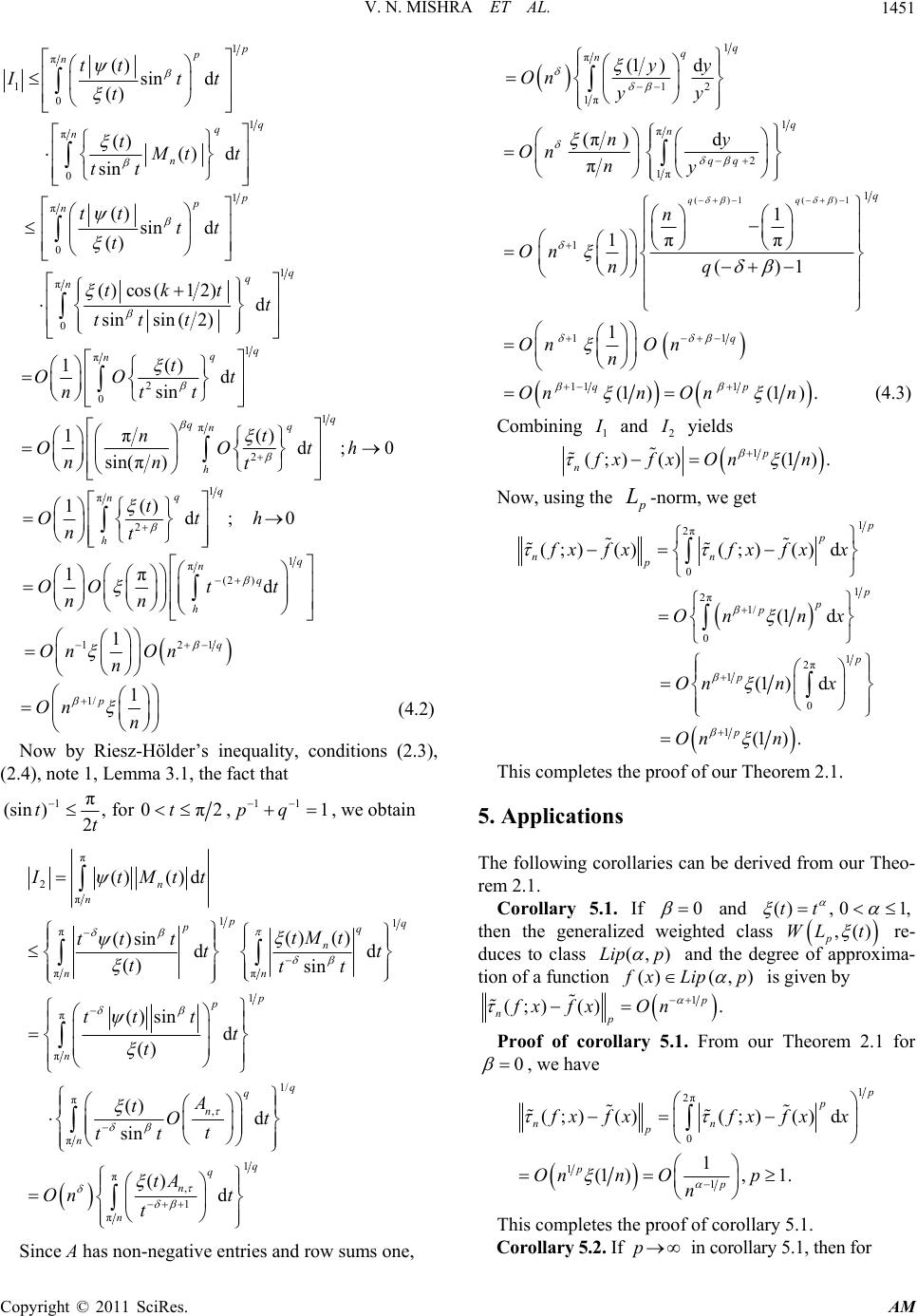 V. N. MISHRA ET AL.1451 1 π 1 0 1 π 0 1 π 0 1 π() cos( 12) q q ntk t 0sin stt 2 () sin d () () () d sin () sin d () d in (2) sin p p n q q n n p p n tt Itt t tMt t tt tt tt t t t ntt 1( )t OO 1 πq q n 0 1 π 2 1 π 2 1 π (2 ) 1 d 1π() d; 0 sin(π) 1() d; 0 1πd 1 q qq n h q q n h q n q h t nt OOth nn t t Oth nt OOtt nn On n 21 1/ 1 q p On On n (4.2) Now by Riesz-Hölder’s inequality, conditions (2.3), (2.4), note 1, Lemma 3.1, the fact that 1π (sin), for0π2 2 tt t ,11 1pq , we obtain π 2 π 11 π ππ 1 π π 1/ π , () d sin q q n A tOt t tt ()1()1 1 π 12 1π 1 π 2 1π 1 1 1 (1 )d (π)d π 1 1ππ ()1 1 qq q q n q n qq q yy On yy ny On ny n On nq On On n 1 11 1 (1)(1). (4.3) q qp OnnOnn π , () ()d () () ( )sindd () sin ( )sind () () n n pq pq n nn p p n n n ItMtt tM t tt t tt ttt tt t t t tA On t 1 π 1 π d q q n t Since A has non-negative entries and row sums one, Combining 1 I and 2 I yields 1 (;)()(1). p fx fxOnn n Now, using the -norm, we get p L 1 2π 0 1 2π 1/ 0 1 2π 1 0 1 (;) ()(;)()d (1 d (1 )d (1) . p p nn p p p p p p p fx fxfx fxx On nx Onnx On n This completes the proof of our Theorem 2.1. 5. Applications The following corollaries can be derived fromheo- rem 2.1. If our T Corollary 5.1. 0 and generalized weighted class () ,01,tt ,() p WLt re- then the duces to class (,Lip )p and () Lip the tion of a functi degree of approxima- ) on fx ( ,p is given by 1p (;)(). np fx fxOn Proof of corollary 5.1. From our Theorem 2.1 for , we have 0 p 1 2π 0 1 1 (1 ), 1. (;)()(;)()d 1 p nn p p p f xfxfxfx x e proof of corollary 5.1. On nOp n This completes th Corollary 5.2. If p in corollary 5.1, then for Copyright © 2011 SciRes. AM 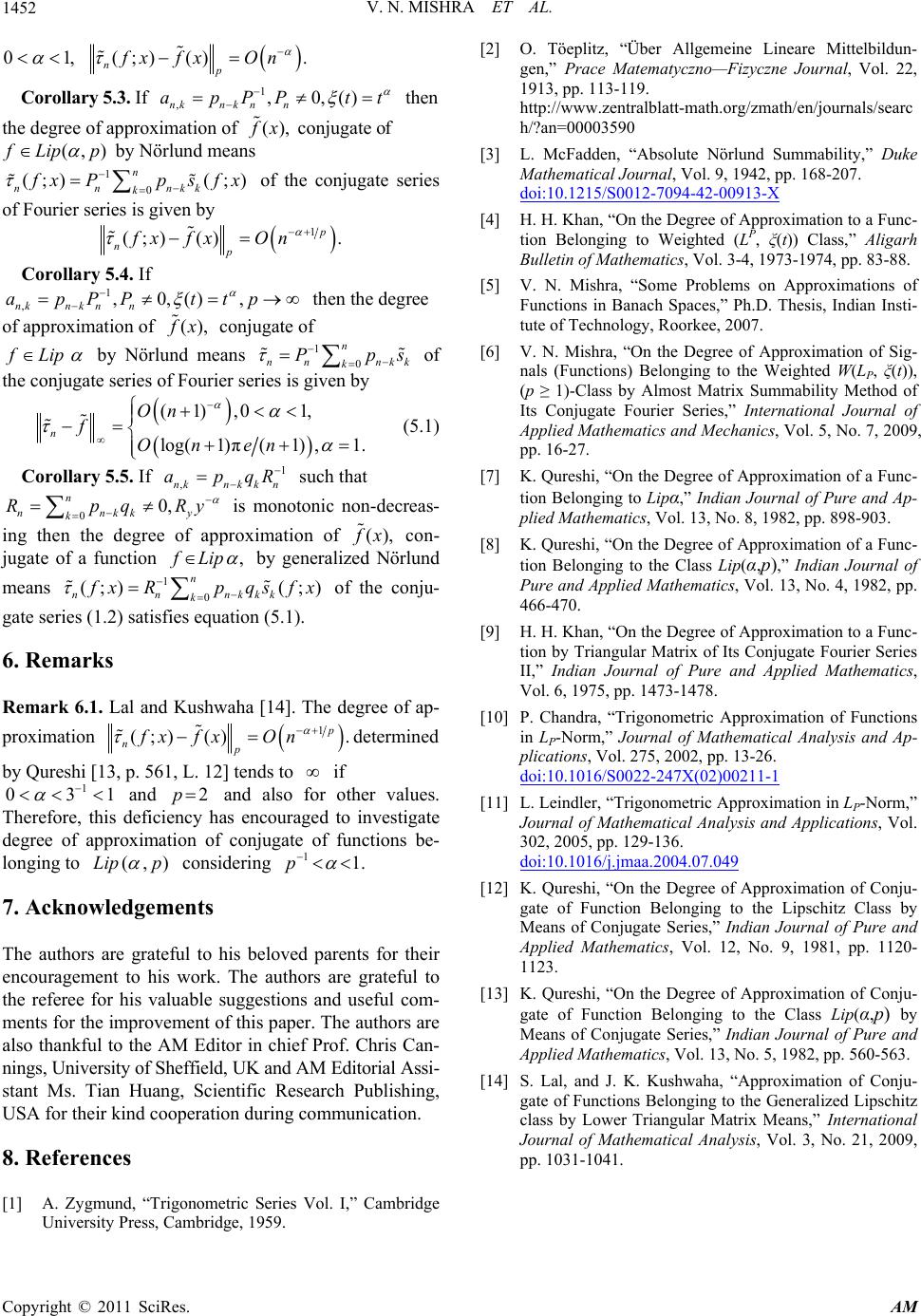 V. N. MISHRA ET AL. Copyright © 2011 SciRes. AM 1452 01, (;)(). np fx fxOn Corolla ry 5.3. If 1 ,,0,() nknknn apPP tt then the degree of approximation of (), f x conjugate o (,) f f Lip p by Nörlund means 1 (;) nn k0(;) n nkk f xP the conjugate series psfx of of Fourier series is given by 1 (;)(). p np fx fxOn rollary 5.4. Co If then the degree 1 ,,0,(), nknknn apPP ttp of approximation of (), f x conjugate of f Lip by Nörlmeans und 1 0 n nn nk kk P ps ries is given by of ate series of Fourier sethe conjug log( nf (1),0 1,On Corollary 5.5. If such that 1)π(1), 1.Onen (5.1) 1 ,nknkkn apqR 0,qRy 0n kk k n n y Rp is monot g then the degre onic non-decreas- ine of approximation of (), f x con- jugate of a function , f Lip generalized Nö 1 0 )n by means rlund (; (;) nn nkkk k f xR pqs fx of the conju- gate series (1.2) satisfies equatio 6. Remarks R Kushwaha [14]. The degree o proximation n (5.1). emark 6.1. Lal andf ap- 1. p determined (;)()fx fxOn if val estigate oxim conjunctions be- np by Qureshs to i [13, p. 561, L. 12] tend 1 031 and 2p and also for otherues. Therefore, this deficiency has encouraged to inv degree of appr longing to Lip ation of ) ugate of f (,p considering 7.ents for uable sug or the improvement of this paper. of. Chris C ings, University of Sheffield, UK and AM Editorial Assi- Huang, Scientific Research Publishing, SA for their kind cooperation during communication. es Cambridge University te zne JournaVol. 22, . 113-119. th.org/zmath/en/journals/searc 11.p Acknowledgem The authors are grateful to his beloved parents their encouragement to his work. The authors are grateful to the referee for his valgestions and useful com- ments fThe authors are also thankful to the AM Editor in chief Pran- n stant Ms. Tian U 8. Referenc [1] A. Zygmund, “Trigonometric Series Vol. I,” Press, Cambridge, 1959. [2] O. Töeplitz, “Über Allgemeine Lineare Mittelbildun- gen,” Prace Mamatyczno—Fizyc l, 1913, pp http://www.zentralblatt-ma h/?an=00003590 [3] L. McFadden, “Absolute Nörlund Summability,” Duke Mathematical Journal, Vol. 9, 1942, pp. 168-207. doi:10.1215/S0012-7094-42-00913-X [4] H. H. Khan, “On the Degree of Approximation to a Func- tion Belonging to Weighted (LP, ξ(t)) Class,” Aligarh Bulletin of Mathematics, Vol. 3-4, 1973-1974, pp. 83-88. [5] V. N. Mishra, “Some Problems on Approximations of Functions in Banach Spaces,” Ph.D. Thesis, Indian Insti- tute of Technology, Roorkee, 2007. [6] V. N. Mishra, “ nals (Function On the Degree of Approximation of Sig- s) Belonging to the Weighted W(LP, ξ(t)), (p ≥ 1)-Class by Almost Matrix Summability Method of , Vol. 5, No. 7, 2009, α,” Indian Journal of Pure and Ap- he Degree of Approximation of a Func- 2, pp. cal Analysis and Ap- Its Conjugate Fourier Series,” International Journal of Applied Mathematics and Mechanics pp. 16-27. [7] K. Qureshi, “On the Degree of Approximation of a Func- tion Belonging to Lip plied Mathematics, Vol. 13, No. 8, 1982, pp. 898-903. [8] K. Qureshi, “On t tion Belonging to the Class Lip(α,p),” Indian Journal of Pure and Applied Mathematics, Vol. 13, No. 4, 198 466-470. [9] H. H. Khan, “On the Degree of Approximation to a Func- tion by Triangular Matrix of Its Conjugate Fourier Series II,” Indian Journal of Pure and Applied Mathematics, Vol. 6, 1975, pp. 1473-1478. [10] P. Chandra, “Trigonometric Approximation of Functions in LP-Norm,” Journal of Mathemati plications, Vol. 275, 2002, pp. 13-26. doi:10.1016/S0022-247X(02)00211-1 [11] L. Leindler, “Trigonometric Approximation in LP-Norm,” Journal of Mathematical Analysis and Applications, Vol. 302, 2005, pp. 129-136. doi:10.1016/j.jmaa.2004.07.049 nd unction Belonging to the Class Lip(α,p) by the Generalized Lipschitz [12] K. Qureshi, “On the Degree of Approximation of Conju- gate of Function Belonging to the Lipschitz Class by Means of Conjugate Series,” Indian Journal of Pure a Applied Mathematics, Vol. 12, No. 9, 1981, pp. 1120- 1123. [13] K. Qureshi, “On the Degree of Approximation of Conju- gate of F Means of Conjugate Series,” Indian Journal of Pure and Applied Mathematics, Vol. 13, No. 5, 1982, pp. 560-563. [14] S. Lal, and J. K. Kushwaha, “Approximation of Conju- gate of Functions Belonging to class by Lower Triangular Matrix Means,” International Journal of Mathematical Analysis, Vol. 3, No. 21, 2009, pp. 1031-1041. |

